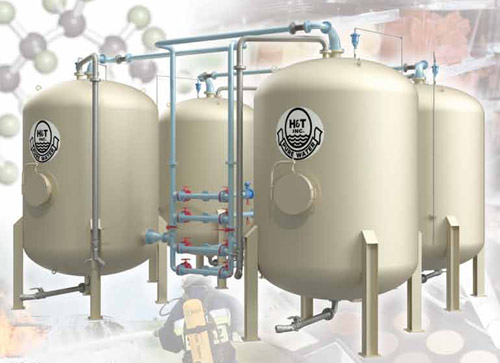M270 PFAS Treatment for Industrial Water Systems
Innovative PFAS Treatment Solutions for Safer Water
The boosting occurrence of PFAS contamination in water supplies demands a crucial evaluation of ingenious therapy options. Advanced filtration innovations and unique chemical therapies existing appealing avenues for lowering these relentless toxins. Furthermore, emerging bioremediation methods provide a more lasting method to tackling PFAS difficulties. As governing frameworks remain to adapt, recognizing the effectiveness and scalability of these options ends up being paramount. What ramifications do these developments hold for public health and environmental remediation, and just how can stakeholders efficiently apply them in diverse contexts?
Introduction of PFAS Contamination
PFAS contamination has become a significant ecological and public health worry. Per- and polyfluoroalkyl compounds (PFAS) are a group of artificial chemicals known for their persistence in the atmosphere and human body, leading them to be frequently described as "permanently chemicals." These compounds have actually been extensively utilized in various industries, including firefighting foams, water-repellent textiles, and food packaging, mainly as a result of their water- and grease-resistant residential properties.
The prevalent use of PFAS has resulted in their discovery in dirt, water materials, and even in the blood of humans and animals. Researches have connected PFAS exposure to various wellness concerns, consisting of developing impacts in babies, immune system dysfunction, and numerous types of cancer cells. In addition, the environmental perseverance of these compounds complicates their deterioration and elimination, elevating issues about lasting eco-friendly effects.
Governing bodies are progressively carrying out rigid standards to check and minimize PFAS levels in alcohol consumption water and other ecological tools. As awareness of PFAS contamination grows, it has become important for neighborhoods and sectors to look for efficient therapy options to minimize exposure and safeguard public health and wellness.
Advanced Filtration Technologies
As the seriousness to deal with PFAS contamination escalates, progressed purification technologies have actually become a crucial element in the removal initiatives focused on getting rid of these consistent chemicals from water sources. These technologies utilize advanced mechanisms to efficiently target and record PFAS compounds, which are notoriously immune to conventional treatment methods.
One of one of the most promising methods is the usage of granular activated carbon (GAC), which adsorbs PFAS molecules as a result of its high area and permeable framework. This technique has actually been widely implemented in both metropolitan and commercial settings, showing significant reductions in PFAS focus. In addition, ion exchange materials have actually obtained grip, specifically designed to uniquely bind PFAS ions from water, thus facilitating their removal.
Membrane layer filtration modern technologies, such as reverse osmosis and nanofiltration, also show efficiency in PFAS removal by literally dividing contaminants from water - pfas management. These systems can attain high degrees of purity, making them appropriate for drinking water applications
Chemical Treatment Developments
Numerous chemical therapy innovations are being checked out to properly address PFAS contamination in water products. One appealing strategy includes using innovative oxidation procedures (AOPs), which use effective oxidants such as ozone, hydrogen peroxide, or chlorine dioxide integrated with UV light to break down PFAS substances into much less damaging materials. This approach has actually shown efficacy in lab setups, showing prospective for scalability in real-world applications.
Another ingenious strategy is the advancement of ion-exchange resins especially made to target PFAS. These resins can uniquely adsorb PFAS compounds from water, enabling for their removal during therapy procedures. Current innovations have improved the performance and capability of these resins, making them a positive alternative for water therapy centers.
Furthermore, researchers are investigating the use of chemical representatives like persulfate and ferrous ions to boost the degradation of PFAS in infected water. These agents can cause chemical reactions that promote the break down of persistent PFAS compounds.
Arising Bioremediation Methods
Recent advancements in chemical therapy technologies have actually led the way for discovering bioremediation techniques as a feasible choice for addressing PFAS contamination. Bioremediation uses the all-natural metabolic processes of look at this now microbes to deteriorate or transform pollutants, making it an appealing approach for taking on persistent pollutants like PFAS.
Arising strategies in bioremediation include making use of genetically crafted bacteria that can especially target and damage down PFAS compounds. These microbial stress are being developed for their improved destruction capabilities, raising the efficiency of the remediation process. In addition, researchers are investigating the potential of plant-assisted bioremediation, where particular plant types may uptake and withdraw PFAS from contaminated soil and water.
One more appealing technique is the application of bioaugmentation, which includes introducing useful bacteria into polluted settings to increase the deterioration of PFAS. This technique can help with faster remediation timelines and enhance overall effectiveness.

Governing Structures and Criteria
A detailed regulative framework is important for efficiently taking care of PFAS contamination and ensuring public health defense. The enhancing acknowledgment of per- and polyfluoroalkyl substances (PFAS) as toxic wastes has actually motivated numerous government and state agencies to create requirements that govern their presence in water supplies. The United State Environmental Protection Company (EPA) has established health and wellness advisories and is working towards setting enforceable restrictions for PFAS in drinking water.
State-level guidelines vary dramatically, with some states embracing stricter look at more info standards than those suggested by the EPA. These laws frequently consist of optimum contaminant degrees (MCLs) for details PFAS substances, tracking demands, and reporting responsibilities for water energies. In addition, emerging structures focus on the remediation of contaminated sites, stressing the requirement for effective therapy innovations.

Final Thought
To conclude, the development and execution of innovative PFAS therapy remedies are vital for attending to the pervasive concern of water contamination. Advanced purification modern technologies, chemical treatments, and arising bioremediation strategies collectively present a multifaceted approach to effectively lower and break you could try these out down PFAS levels. As governing structures remain to advance, incorporating these innovations will be necessary to guard public health and bring back the honesty of polluted water sources, ultimately adding to a cleaner and much safer setting.